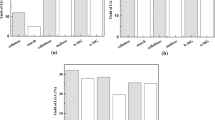Summary
The thermally induced decomposition of disaccharide Amadori compounds has been compared to those of monosaccharide ones under almost water-free conditions. The structure of the synthesized maltulosyl compound has been proved to be4 C 1-α-d-glucopyranosyl-(1→4)-2 C 5-β-d-fructopyranosylglycine by1H-and13C-NMR spectroscopy. The decomposition of Amadori compounds has been used to study the kinetics of the browning reaction. Compared to fructosylglycine and maltotriulosylglycine, the browning of the disaccharide is faster. Curie point pyrolysis at 300° C and investigation of the pyrolysate by gas chromatography/mass spectrometry have shown that the disaccharide component influences the thermal process. Furanes and furanones have been detected as predominant degradation products, the main one being 2(5H)-furanone. For the first time, we suggest a reaction pathway for the formation of these products via the Maillard reaction which includes 1,6-anhydroglucose.
Zusammenfassung
Untersucht wird der thermisch induzierte Abbau von Disaccharid-Amadori-Verbindungen in quasi wasserfreiem Reaktionsmilieu. Die Struktur der synthetisierten Maltulosylverbindung wird über die Aufnahme von1H- und13C-NMR-Spektren als4 C 1-α-d-Glucopyranolsyl-(1→4)-2 C 5-β-d-fructopyranosylglycin bestimmt. Im Vergleich zum Fructosyl- und Maltotriulosylglycin bräunt das Disaccharid-Derivat unter den angegebenen Reaktionsbedingungen stärker. Über die Curiepunkt-Pyrolyse der Amadori-Verbindungen bei 300 °C und anschließende GC/MS-Analyse der Spaltprodukte werden bevorzugt Furankörper nachgewiesen, von denen das 2(5H-Furanon mengenmäßig dominiert. Ein Reaktionsweg der Bildung solcher Furanone aus Disacchariden wird vorgeschlagen. Erstmals erfolgt die Einbeziehung von 1,6-Anhydroglucose in die Diskussion zum Verlauf der Maillard-Reaktion.
Similar content being viewed by others
Literatur
Shigematsu H, Shibata S, Kurata T, Kato H, Fujimaki M (1977) Agric Biol Chem 41:2377
Birch EJ, Lelievre J, Richards EL (1984) Carbohyd Res 83:263
Westphal G, Örsi F, Kroh L (1988) Nahrung 32:109
Wittmann R, Eichner K (1989) Z Lebensm Unters Forsch 188:212
Heinzler M, Eichner K (1991) Z Lebensm Unters Forsch 192:24
Hodge JE, Fisher BE (1963) Methods Carbohyd Chem 2:279
Röper H, Röper S, Heyns K (1983) Carbohyd Res 116:183
Moll N, Gross B, Vinh T, Moll M (1983) Instr Anal Foods 1:279
Khan R (1981) Adv Carbohyd Chem Biochem 39:213
Löschner J, Kroh L, Vogel J (1990) Z Lebensm Unters Forsch 191:302
Baltes W (1988) J Anal Appl Pyrolysis 8:533
Baltes W, Schmahl HJ (1978) Z Lebensm Unters Forsch 167:69
Helleur RJ (1987) J Anal Appl Pyrolysis 11:297
Schrödter R (1992) Dissertation, TU Berlin (in Vorbereitung)
Theander O (1988) Adv Carbohyd Chem Biochem 46:316
Ledl F, Schleicher E (1990) Angew Chem 102:597
Shibamoto T, Bernhard RA (1977) J Agric Food Chem 25:609
Klostermeyer H (1986) Monatsschr Brauwiss 39:231
Neye L (1992) Dissertation, TU Berlin (in Vorbereitung)
Qhnishi H, Kalo K, Takagi E (1975) Polym J 7:431
Tomasik P, Palasinski M, Wiejak S (1989) Adv Carbohyd Chem Biochem 47:203, 279
Author information
Authors and Affiliations
Rights and permissions
About this article
Cite this article
Kroh, L., Mügge, C., Schröder, R. et al. Thermisch induzierter Abbau von Disaccharid-Amadori-Verbindungen in quasi wasserfreiem Reaktionsmilieu. Z Lebensm Unters Forch 194, 216–221 (1992). https://doi.org/10.1007/BF01198410
Received:
Issue Date:
DOI: https://doi.org/10.1007/BF01198410




